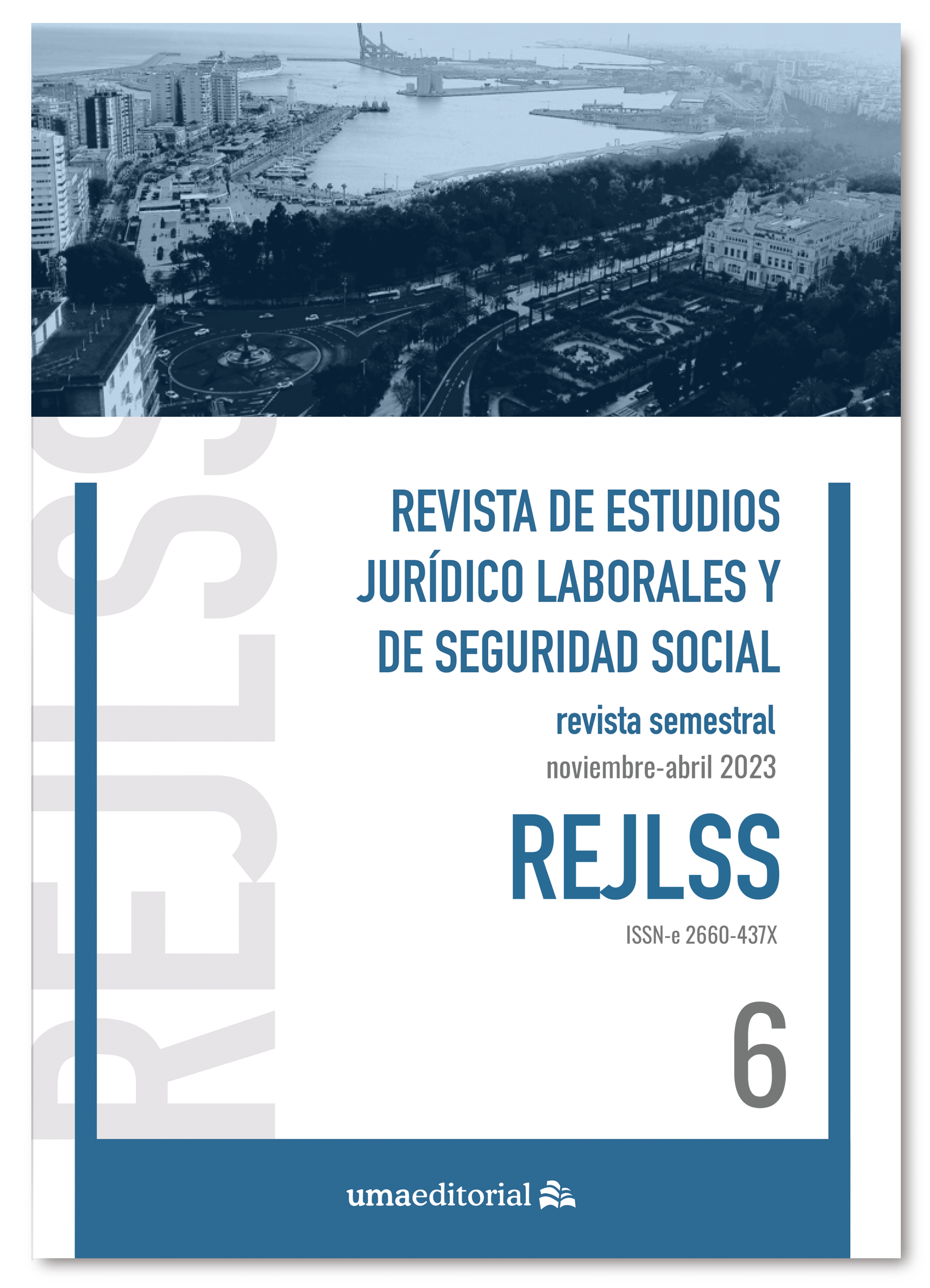Limitations on the Free Movement of Workers
Special reference to the concept of public function
DOI:
https://doi.org/10.24310/rejlss.vi6.16016Keywords:
free movement, workers, public administration, public employmentAbstract
After the Treaty establishing the European Community, article 39 recognized the free movement of workers with the prohibition of discrimination based on the nationality of another Member State, except in the case of public administrations. This article analyzes how European jurisprudence has followed a definition of public administration and public employment to overcome this obstacle or limit to the free movement of workers in certain cases.
Downloads
Metrics
Publication Facts
Reviewer profiles N/A
Author statements
Indexed in
-
—
- Academic society
- N/A
- Publisher
- Universidad de Málaga. UMA Editorial
References
Arroyo Jiménez, L., “El Derecho Administrativo Europeo como sistema”, Revista de Derecho Público: Teoría y Método, Vol. 1, 2020.
Calonge Velázquez, A., “El concepto de administración pública en la Unión Europea: administración pública nacional y administración pública comunitaria”, Revista de Derecho de la Unión Europea, núm. 19, 2010.
Dashwood, A. y otros, Wyatt and Dashwood’s European Union Law, Hart Publishing, Oxford y Portland, (6ª ed.), 2011.
Denizeau-Lahaye, VV.AA. (Amilhat, M. Dir.), Les concepts fondateurs et les principes directeurs du droit administratif européen, Presses de l´Université Toulouse 1 Capitole, 2021.
Druesne, G., “La liberté de circulation des persones dans la CEE et les “emplois dans l’administration publique” (sur un arrêt du 17 décembre 1980 de la Cour de justice des Communautés européennes)”, Revue trimestrielle de droit européen, núm. 2, 1981.
Fernández Lozano, E., “El acceso a las funciones públicas nacionales por los ciudadanos de la Unión Europea”, Autonomíes, núm. 25, 1999.
Fuentetaja Pastor, J.A., “La libre circulación de empleados públicos”, Revista de Derecho de la Unión Europea, núm. 5, 2003.
Gómez Muñoz, J.M., “La libertad de circulación de trabajadores en el empleo público”, Consejo Económico y Social (España), 1996.
Handoll, J., “Article 48(4) EEC and No-National Access to Public Employment”, European, Law Review, núm.13, 1988.
Millán Moro, L., “Algunas limitaciones a la libre circulación de personas en el Tratado CEE”, Gaceta Jurídica de la CE, D-9, 1988.
Mir Puigpelat, O., “La codificación del procedimiento administrativo en la unión administrativa europea”, en AAVV (Velasco Caballero, F. y Scheider, J.P. coord.), La Unión Administrativa Europea, Marcial Pons, Madrid-Barcelona-Buenos Aires, 2008
Monereo Pérez, J.L., “La libre circulación de trabajadores en las Administraciones Públicas de los países comunitarios. A propósito del Proyecto de Ley sobre el acceso a determinados sectores de la Función pública de los nacionales de los demás Estados miembros de la
Comunidad Económica Europea”, Relaciones laborales, Sección Doctrina, Editorial La Ley, tomo 1, 1994.
Monereo Pérez, J.L. y Vida Soria, J., La condición de nacionalidad en el acceso del personal a los empleos públicos, Ministerio para las Administraciones Públicas, Madrid, 1991.
Monereo Pérez, J.L. y Ortega Lozano, P.G., “La libre circulación de trabajadores nacionales de los Estados miembros: discriminación por razón de nacionalidad e igualdad de condiciones laborales”, La Ley Unión Europea, núm. 51, 29 de septiembre de 2017.
Noguera López, A., “La jurisprudencia del TJCE en materia de acceso a empleos en la administración pública de ciudadanos comunitarios”, Revista Vasca de Administración Pública, núm. 39, 1994.
Schmidt- Assman, E., “Cuestiones fundamentales sobre la reforma de la Teoría General del derecho administrativo”, en AAVV (Barnés, J. coord..), Necesidad de la innovación y presupuestos metodológicos, Innovación y reformas en el derecho administrativo, Editorial Derecho Global, Sevilla, 2006.
Downloads
Published
How to Cite
Issue
Section
License
In the Revista de Estudios Juridico Laborales y de Seguridad Social (REJLSS) we are clearly committed to a policy of open access to scientific knowledge (See Berlin Declaration).
Those authors who have publications with this journal accept the following terms:
This journal provides immediate free access to its content under the principle of making research freely available to the public. All the contents published in the REJLSS are subject to the Creative Commons license
Attribution-NonCommercial-NoDerivatives 4.0 International (CC BY-NC-ND 4.0)
Copyrights are of two kinds: moral and patrimonial. Moral rights are perpetual, inalienable, non-transferable, inalienable, unattachable and imprescriptible prerogatives. In accordance with Spanish copyright legislation, the authors who publish in REJLSS retain the moral right over their work, as well as the ownership of the patrimonial right, which will be transferred to the University of Malaga for its dissemination in open access.
The patrimonial rights, refer to the benefits that are obtained by the use or disclosure of the works. REJLSS is published in open access and is exclusively authorized to perform or authorize by any means the use, distribution, dissemination, reproduction, adaptation, translation or transformation of the work.
It is the responsibility of the authors to obtain the necessary permissions of the images that are subject to copyright.
Authors whose contributions are accepted for publication in this journal retain the non-exclusive right to use their contributions for academic, research and educational purposes, including self-archiving or depositing in open access repositories of any kind.
The electronic edition of this magazine is edited by the Editorial of the University of Malaga (UmaEditorial), being necessary to cite the origin in any partial or total reproduction.
The authors may adopt other non-exclusive license agreements for the distribution of the version of the published work (eg: deposit it in an institutional telematic archive or publish it in a monographic volume) provided that the initial publication is indicated in this magazine.
Authors are allowed and recommended to disseminate their work through the Internet (eg, in institutional telematic archives or on their website) before and during the submission process, which can produce interesting exchanges and increase citations of the published work.







19.png)
